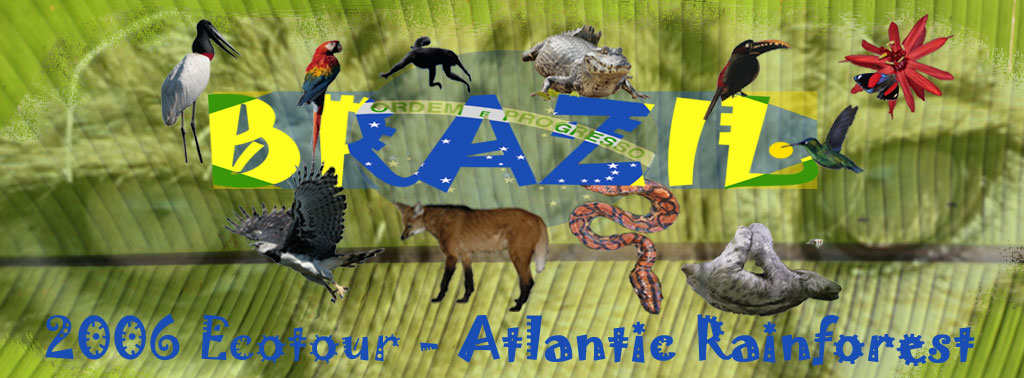



Added 3 September 2006
Day 4: Friday, June 9, 2006
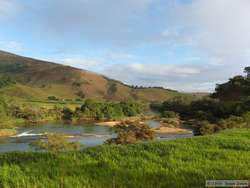 When I woke up the next morning, I knew I wasn't completely well, but I did feel better, and I wasn't about to stay at the hotel. After we all had a mediocre breakfast with really sour fresh fruit juice at the hotel, we headed out to Caratinga Biological Station. Not far out of Ipanema, the road turned to dirt, and we stopped often as we sighted new species. The road also followed a beautiful river, which Shan was fond of capturing on film, so our progress to Caratinga was slow, but we did eventually make it.
When I woke up the next morning, I knew I wasn't completely well, but I did feel better, and I wasn't about to stay at the hotel. After we all had a mediocre breakfast with really sour fresh fruit juice at the hotel, we headed out to Caratinga Biological Station. Not far out of Ipanema, the road turned to dirt, and we stopped often as we sighted new species. The road also followed a beautiful river, which Shan was fond of capturing on film, so our progress to Caratinga was slow, but we did eventually make it.
We kept seeing interesting birds along the way as well, so the river wasn't the only thing stopping us from reaching the Caratinga Biological Station at the Muriqui Preserve.
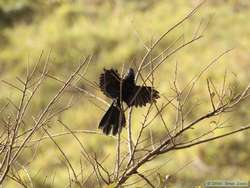
|
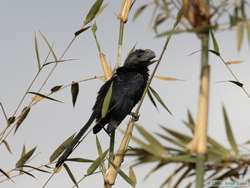
|
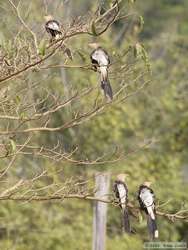
|
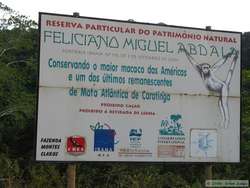
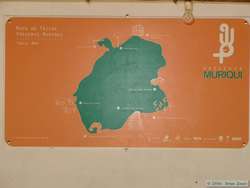 Caratinga Biological Station is a preserve and research station established by Feliciano Miguel Abdala, a former coffee plantation owner. Mr. Abdala (or Mr. Feliciano as some of the signs called him) came to love the muriqui monkeys (Brachyteles hypoxanthus) that inhabited his land so much that he turned the plantation, which contained large tracts of unspoiled Atlantic Rainforest, into the Preserve. Biologists now research the muriqui here in hopes of preserving this extremely rare primate. The muriqui monkey is the largest (up to 12 kilograms or 26.5 pounds) and most endangered primate in South America.
Caratinga Biological Station is a preserve and research station established by Feliciano Miguel Abdala, a former coffee plantation owner. Mr. Abdala (or Mr. Feliciano as some of the signs called him) came to love the muriqui monkeys (Brachyteles hypoxanthus) that inhabited his land so much that he turned the plantation, which contained large tracts of unspoiled Atlantic Rainforest, into the Preserve. Biologists now research the muriqui here in hopes of preserving this extremely rare primate. The muriqui monkey is the largest (up to 12 kilograms or 26.5 pounds) and most endangered primate in South America.
 When we got to the entrance to Caratinga, there was a huge square hole dug into the ground right in the center of the road.
When we got to the entrance to Caratinga, there was a huge square hole dug into the ground right in the center of the road. 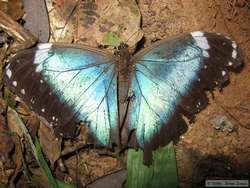 It appeared that plans were afoot to put a cattle guard in, but no provision was made to allow entry in the meantime, though we did notice that there was no fence to the right of the entry way, and it appeared that several vehicles had driven that way.
It appeared that plans were afoot to put a cattle guard in, but no provision was made to allow entry in the meantime, though we did notice that there was no fence to the right of the entry way, and it appeared that several vehicles had driven that way. 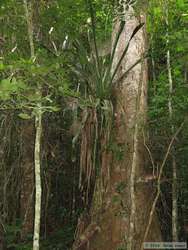 The problem was that we were in a rather tall, skinny Sprinter van, and the route was essentially along the side of a hill, so it was sloping pretty steeply for the van. We thought that we might have to get out and walk the rest of the way, but Marclei decided to go for it. He obviously wasn't used to driving a vehicle off-road though, because he cut it too close the large wooden pillars that formed the entry way and smacked the top edge of the van on it. The damage wasn't too bad, but he obviously wasn't too happy about it.
The problem was that we were in a rather tall, skinny Sprinter van, and the route was essentially along the side of a hill, so it was sloping pretty steeply for the van. We thought that we might have to get out and walk the rest of the way, but Marclei decided to go for it. He obviously wasn't used to driving a vehicle off-road though, because he cut it too close the large wooden pillars that formed the entry way and smacked the top edge of the van on it. The damage wasn't too bad, but he obviously wasn't too happy about it.
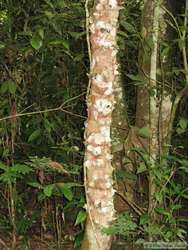
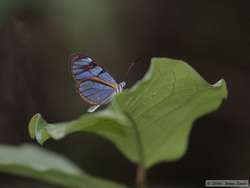 Once at the biological station itself, we went for a hike up a small dirt road. It was a grey day, but we managed to get through it without any rain. Right off the bat, I got a very brief glimpse at a red-rumped agouti (Dasyprocta agoti), a large rodent about the size of a small house cat. Before long, we encountered a small troop of Black-capped Capuchin (Cebus apella nigritis). It was fun to watch them move around in the trees and use their prehensile tail.
Once at the biological station itself, we went for a hike up a small dirt road. It was a grey day, but we managed to get through it without any rain. Right off the bat, I got a very brief glimpse at a red-rumped agouti (Dasyprocta agoti), a large rodent about the size of a small house cat. Before long, we encountered a small troop of Black-capped Capuchin (Cebus apella nigritis). It was fun to watch them move around in the trees and use their prehensile tail.
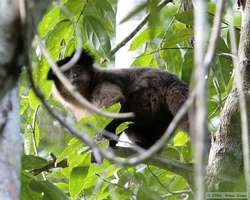
|
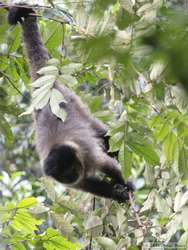
|
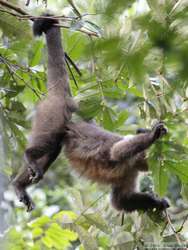
|
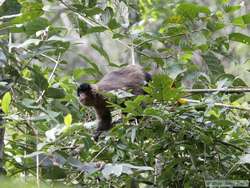
|
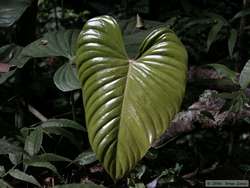
|
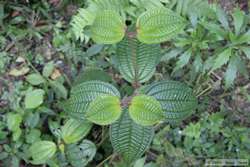
|
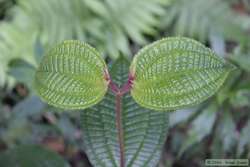
|
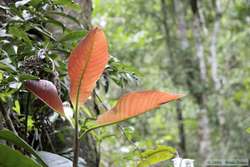
|
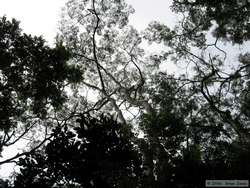
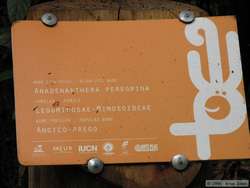 Though similar in form to those we saw at Caraca, we saw many new species of plants. Many of the species of trees were labeled, which was nice, as Fabricio is really good with his birds and quite good with mammals, but not so good with plants. Since I'm really interested in learning about an area holistically, this was the only short-coming I found in the whole trip, and even that was a minor one, as Fabricio did know quite a bit about ecosystems as a whole, just not as much as I would have liked. Chalk it up to my voracious apetite for knowledge.
Though similar in form to those we saw at Caraca, we saw many new species of plants. Many of the species of trees were labeled, which was nice, as Fabricio is really good with his birds and quite good with mammals, but not so good with plants. Since I'm really interested in learning about an area holistically, this was the only short-coming I found in the whole trip, and even that was a minor one, as Fabricio did know quite a bit about ecosystems as a whole, just not as much as I would have liked. Chalk it up to my voracious apetite for knowledge.
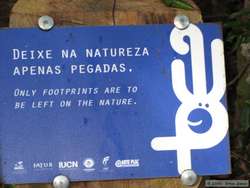
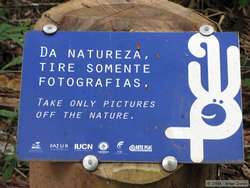 Besides the signs for the trees, they had other signs with messages on them. The signs were in both Portuguese and English, which was much appreciated, and often the source of some amusement as the English translations weren't always quite what I'm sure the writers had in mind.
Besides the signs for the trees, they had other signs with messages on them. The signs were in both Portuguese and English, which was much appreciated, and often the source of some amusement as the English translations weren't always quite what I'm sure the writers had in mind.
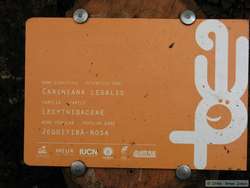
|
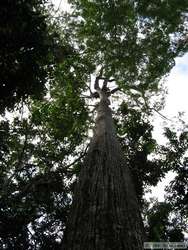
|
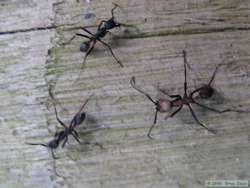
|

|
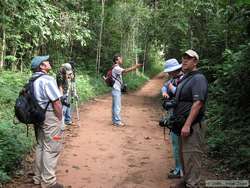
|
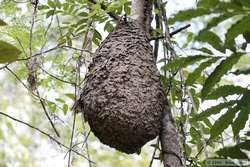
|
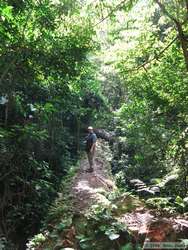
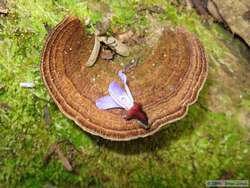 One impressive tree was the Jequitibá (Cariniana legalis), which can grow quite tall. At one point we took a little side trail to a Jequitibá that had fallen down in the spring of 2000, and which we could walk across. The 200 year old tree was 40 meters (130 feet) tall and about 2.16 meters (7.1 feet) in diameter, so it had been, and truly remained, an impressive tree. By walking along it, one could get a good sense of how important this tree continues to be.
One impressive tree was the Jequitibá (Cariniana legalis), which can grow quite tall. At one point we took a little side trail to a Jequitibá that had fallen down in the spring of 2000, and which we could walk across. The 200 year old tree was 40 meters (130 feet) tall and about 2.16 meters (7.1 feet) in diameter, so it had been, and truly remained, an impressive tree. By walking along it, one could get a good sense of how important this tree continues to be.
Shan, of course, thriving off drama, had to fall off of it. I was at the "top" of the tree when I heard a yelp. When I turned around, Shan had disappeared. Dave, who was closer, found her first, and I rushed over to make sure she was alright. She seemed fine, but couldn't get back up on the tree and required Dave and I to help pull her back up.  At least she didn't hurt herself badly, as she was at a point where the tree was laying directly on the ground, rather than being suspended in the air. She made it through the fall with some dirty pants and a slight bruise on her butt. She's actually lucky that she didn't get hurt, as even with the tree lying directly on the ground, it was quite a ways down since she fell off the downhill side. Dave and I had to reach down below the top of the log to reach up up-stretched hand. She was also lucky that she didn't break her new camcorder, which she was carrying at the time.
At least she didn't hurt herself badly, as she was at a point where the tree was laying directly on the ground, rather than being suspended in the air. She made it through the fall with some dirty pants and a slight bruise on her butt. She's actually lucky that she didn't get hurt, as even with the tree lying directly on the ground, it was quite a ways down since she fell off the downhill side. Dave and I had to reach down below the top of the log to reach up up-stretched hand. She was also lucky that she didn't break her new camcorder, which she was carrying at the time.

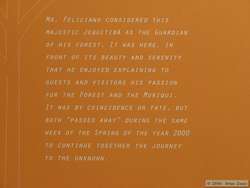 At the spot where the tree once stood, we learned that this particular tree was the one that Mr. Feliciano liked to tell guests about the forest and the muriqui. Whether by fate or coincidence, Mr. Feliciano and this tree died within a week of each other. In honor of both, the Preserve employees planted a new tree to replace the fallen one. After seven years, it is now about 5 feet tall and is less than 1 inch in diameter.
At the spot where the tree once stood, we learned that this particular tree was the one that Mr. Feliciano liked to tell guests about the forest and the muriqui. Whether by fate or coincidence, Mr. Feliciano and this tree died within a week of each other. In honor of both, the Preserve employees planted a new tree to replace the fallen one. After seven years, it is now about 5 feet tall and is less than 1 inch in diameter.
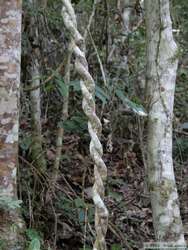 As for the muriqui, they still struggle. With only 5% of the Atlantic Rainforest remaining, preserves like Caratinga are crucial for the survival of the species. The continuing threat to the habitat runs the usual gambit: urbanization, agriculture, mining, industrial, and general development.
As for the muriqui, they still struggle. With only 5% of the Atlantic Rainforest remaining, preserves like Caratinga are crucial for the survival of the species. The continuing threat to the habitat runs the usual gambit: urbanization, agriculture, mining, industrial, and general development. 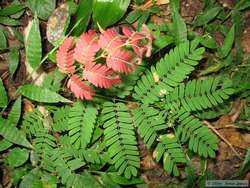 Without strong and immediate protection, the remaining Atlantic rainforest is in grave danger. They have been reduced from a population of about 400,000 down to less than 1,000 for the southern muriqui, and less than 300 for the northern muriqui, the species in Caratinga. For this reason, the southern population is considered endangered, and the northern population is considered critically endangered.
Without strong and immediate protection, the remaining Atlantic rainforest is in grave danger. They have been reduced from a population of about 400,000 down to less than 1,000 for the southern muriqui, and less than 300 for the northern muriqui, the species in Caratinga. For this reason, the southern population is considered endangered, and the northern population is considered critically endangered.
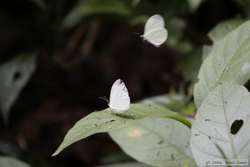
|
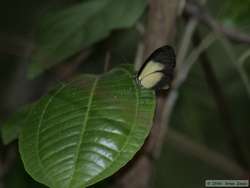
|
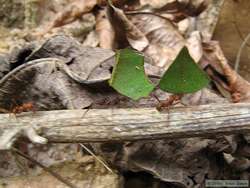
|
On the rest of the hike, we managed to see more primates, the black-capped capuchin (Cebus nigritis), and the brown howler monkey (Alouatta fusca), but no muriqui monkey. We also saw some interesting insects, including some beautiful butterflies. While on the hike, we were met by Carlos, a local who lives at the preserve that Douglas is training to be a guide. He didn't speak English, so stayed pretty quiet. He did help supplement Fabricio with some local knowledge though.
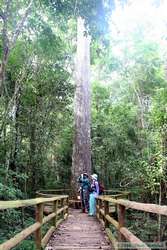
|
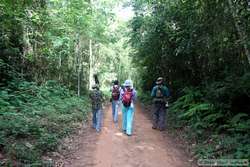
|
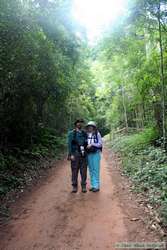
|
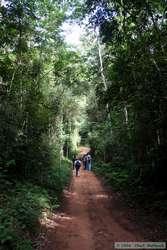
|
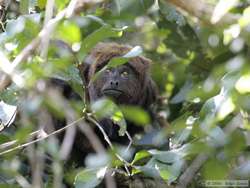
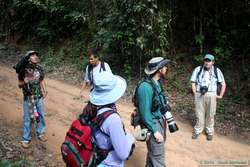 At around noon, we returned to the research station, where Marclei had prepared lunch for us. We found a troop of brown howler monkeys right there at the station, so we tended to alternate between eating and taking pictures of the monkeys. I still wasn't feeling well and barely ate a thing, so I spent most of my time watching and photographing the howler monkeys. I also attempted the frustrating task of taking pictures of a particular species of red butterfly that didn't like to have its picture taken.
At around noon, we returned to the research station, where Marclei had prepared lunch for us. We found a troop of brown howler monkeys right there at the station, so we tended to alternate between eating and taking pictures of the monkeys. I still wasn't feeling well and barely ate a thing, so I spent most of my time watching and photographing the howler monkeys. I also attempted the frustrating task of taking pictures of a particular species of red butterfly that didn't like to have its picture taken.
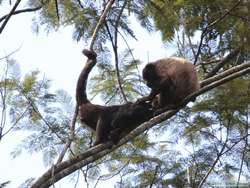
|
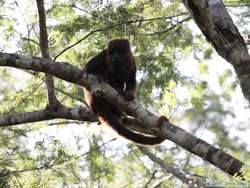
|
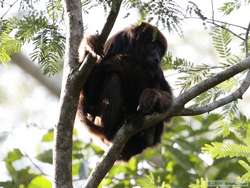
|

|
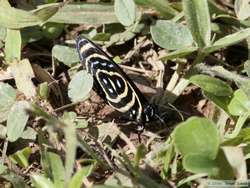
|
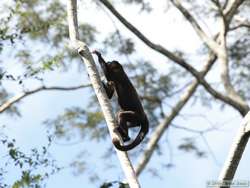
|
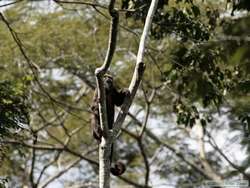
|
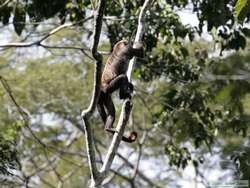
|
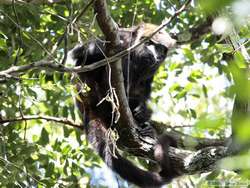
|

|
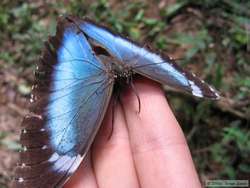
|
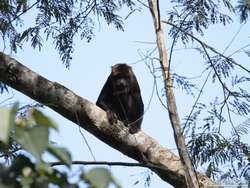
|
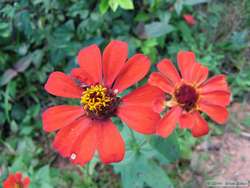
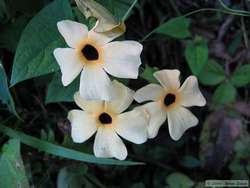 After lunch we walked down the road instead of up, going all the way down to the coffee drying building that we passed on the way in. We saw more interesting birds and got some great shots of a mother brown howler monkey (pictures below). We also stopped at an old mill powered by a water wheel which was quite interesting. The structure was made of wood, so we thought it amazing that the structure hadn't been eaten by termites.
After lunch we walked down the road instead of up, going all the way down to the coffee drying building that we passed on the way in. We saw more interesting birds and got some great shots of a mother brown howler monkey (pictures below). We also stopped at an old mill powered by a water wheel which was quite interesting. The structure was made of wood, so we thought it amazing that the structure hadn't been eaten by termites.
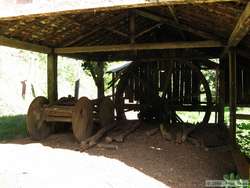
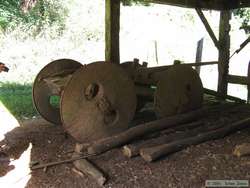 We discovered that the building was made from the wood of the tabebuia tree (Tabebuia impetiginosa), which the termites won't (or can't) eat, I'm assuming because the wood is so hard. The wood of the tabebuia tree is the heaviest and hardest wood in the neotropics. It is so dense, in fact, that the wood of the tabebuia tree sinks in water.
We discovered that the building was made from the wood of the tabebuia tree (Tabebuia impetiginosa), which the termites won't (or can't) eat, I'm assuming because the wood is so hard. The wood of the tabebuia tree is the heaviest and hardest wood in the neotropics. It is so dense, in fact, that the wood of the tabebuia tree sinks in water.
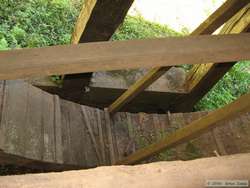
|
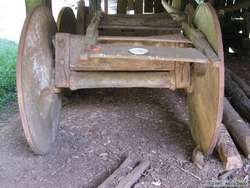
|
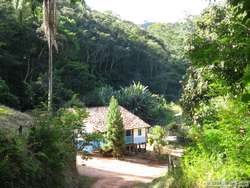
|
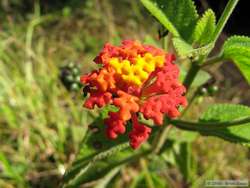 We continued walking down the road towards an old coffee bean processing area. Along the way we saw more birds and female brown howler monkey with a baby up in a secropia tree. At the coffee processing area, we wandered around a bit before heading back. By the time we got to the plantation, I was really tired, feeling worse than ever, and knew I had already taxed my ailing body further than I should have, but had no choice but to walk back up the hill. I felt pretty miserable, but I think everyone else was pretty beat by then as well.
We continued walking down the road towards an old coffee bean processing area. Along the way we saw more birds and female brown howler monkey with a baby up in a secropia tree. At the coffee processing area, we wandered around a bit before heading back. By the time we got to the plantation, I was really tired, feeling worse than ever, and knew I had already taxed my ailing body further than I should have, but had no choice but to walk back up the hill. I felt pretty miserable, but I think everyone else was pretty beat by then as well.
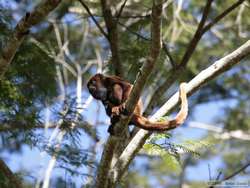
|
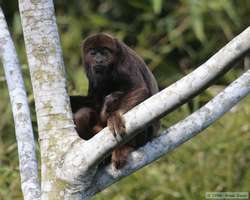
|

|
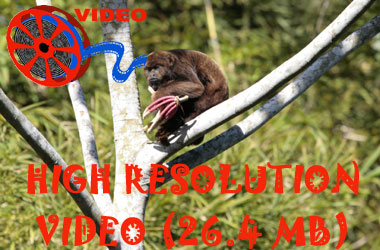
|
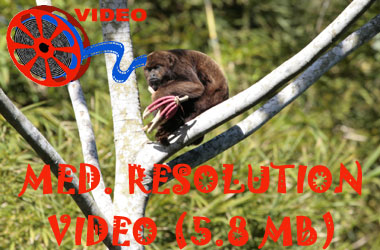
|
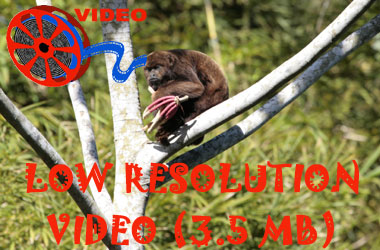
|
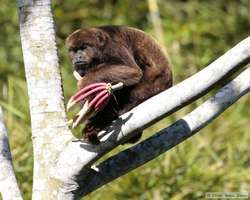
|

|
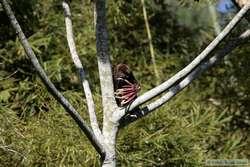
|
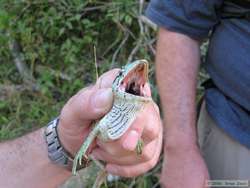
|
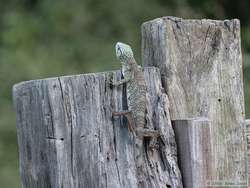
|
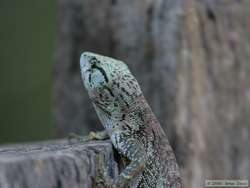
|
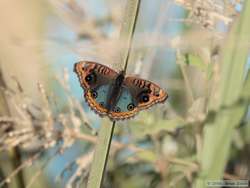
|
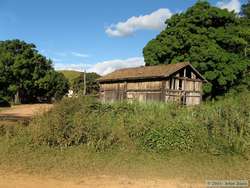
|
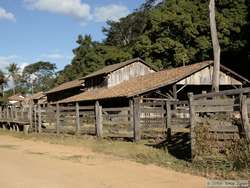
|
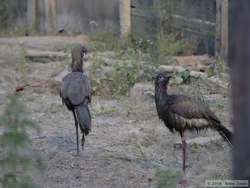
|
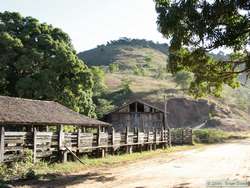
|
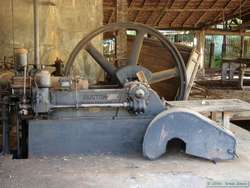
|
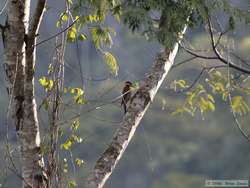
|
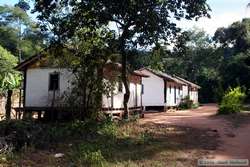
|
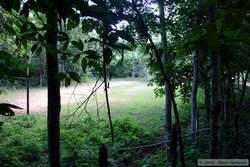
|
When we got back to Ipanema, I showered and laid down for a bit to rest. I had decided to skip going out to dinner again, but at the last minute I decided to go out. It turned out to be a big mistake. Even just walking there, I felt light-headed a couple of times. Then we placed our orders and waited, and waited, and waited for our food. While waiting there, the manager of Caratinga Biological Station, Antonio, stopped by our table, and Fabricio arranged to have him take us to see the muriqui monkeys the next morning. Antonio and Marclei also joked with each other about Marclei's little incident with the van.
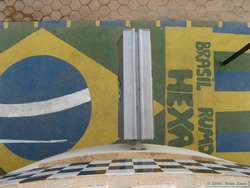 By the time our pizza arrived I was really not feeling well. It was pretty tasty, but I couldn't even finish a whole piece. I just picked at it. Just as Fabricio's pizza arrived, I decided that I really just needed to go back to the room and rest. Shan wanted to go with me, so we left everyone at the restaurant. We tried to find some orange juice and water on the way home, but didn't have any luck on either account. We ended up buying a couple of orange drinks at the hotel, but they weren't very good, and ended up making me feel worse when I drank one the next day.
By the time our pizza arrived I was really not feeling well. It was pretty tasty, but I couldn't even finish a whole piece. I just picked at it. Just as Fabricio's pizza arrived, I decided that I really just needed to go back to the room and rest. Shan wanted to go with me, so we left everyone at the restaurant. We tried to find some orange juice and water on the way home, but didn't have any luck on either account. We ended up buying a couple of orange drinks at the hotel, but they weren't very good, and ended up making me feel worse when I drank one the next day.
Species list for the day (32 birds, 3 mammals, 1 reptile):
Brazilian Teal (Amazonetta brasiliensis)
Black Vulture (Coragyps atratus)
Roadside Hawk (Buteo magnirostris)
American Kestrel (Falco sparverius)
Red-legged Seriema (Cariama cristata)
Southern Lapwing (Vanellus chilensis)
Scaled Dove (Columbina squammata)
Scaly-headed Parrot (Pionus maximiliani)
Smooth-billed Ani (Crotophaga ani)
Guira Cuckoo (Guira guira)
Reddish Hermit (Phaethornis ruber)
Swallow-tailed Hummingbird (Eupetomena macroura)
Black-necked Araçari (Pteroglossus aracari)
Campo Flicker (Colaptes campestris)
Lineated Woodpecker (Dryocopus lineatus)
Variable Antshrike (Thamnophilus caerulescens)
E Scaled Antbird (Drymophila squamata)
White-bearded Manakin (Manacus manacus)
Streamer-tailed Tyrant (Gubernetes yetapa)
Long-tailed Tyrant (Colonia colonus)
Tropical Kingbird (Tyrannus melancholicus)
Great Kiskadee (Pitangus sulphuratus)
Southern Rough-winged Swallow (Stelgidopteryx ruficollis)
Bananaquit (Coereba flaveola)
Green-headed Tanager (Tangara seledon)
Blue Dacnis (Dacnis cayana)
Blue-black Grassquit (Volatinia jacarina)
Yellow-bellied Seedeater (Sporophila nigricollis)
Saffron Finch (Sicalis flaveola)
Green-winged Saltator (Saltator similis)
Red-rumped Cacique (Cacicus haemorrhous)
Crested Oropendola (Psarocolius decumanus)
E Black-capped Capuchin (Cebus apella nigritis)
E Brown Howler monkey (Alouatta fusca)
Red-rumped Agouti (Dasyprocta agouti)
Iguana (Iguana iguana)
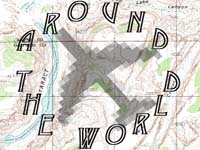 |
 |